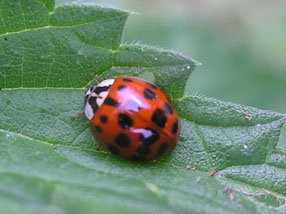Saturday, 26th May 2007
Clayfield Copse, Caversham ~ An Unwanted Visitor

A harlequin ladybird (Harmonia axyridis) has been found at Clayfield Copse.
This ladybird originates from eastern Asia and was introduced to North America as a biological control for aphids and scale insects as early as 1916. In the 1980's it began to become established in the wild and is now one of the most common ladybird species in large parts of North America.
Despite the American experience, it was brought to Europe as a biological control in the 1990's where it again soon started to thrive in the wild.
The first UK recording was in 2004 and while initial sightings were mainly in South East England it has now been found as far west as Cornwall and the Pembrokeshire coast and north as far as Lancashire and North Yorkshire.
Concerns
The harlequin ladybird's voracious appetite for aphids means that it can out-compete native ladybirds and other insects which depend on this food source, putting these populations at risk. It will also feed on the eggs and larvae of other insects, including native ladybirds, lacewings, butterflies and moths, when aphids are scarce.
In the late summer as the harlequin prepares to hibernate, it attacks fruit. They have a particular fondness for grapes and being difficult to remove before pressing, their presence may result in tainted wine.
Its extended breading season along with an ability to withstand a wide range of weather conditions and an ability to fly long distances, all contribute to the harlequin's capacity to spread rapidly, as demonstrated by the UK experience.
Identification and Recording
Harlequin ladybirds are 6-8mm in size, larger than any of the native species and highly variable in appearance, see below, having a black or orange-red wing case and from no spots up to 21, black or orange-red in colour. Of those found in the UK most have been either orange-red with 19 black spots, or black with 2 or 4 orange red spots.
For more information and to record sightings visit the Harlequin Ladybird Survey website at www.harlequin-survey.org.
(For information about other species of ladybird visit the Ladybird Survey website at www.ladybird-survey.org).
Our thanks to Jill Verran for making the discovery and allowing us to use her photograph. Jill has been taking wildlife photo's at Clayfield Copse since April 2007 and we hope to include more on the website in the future.
